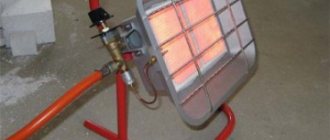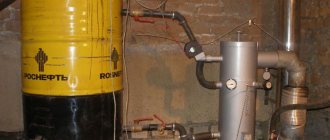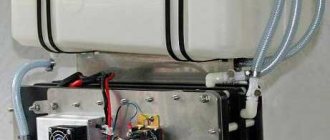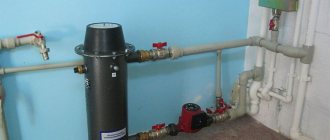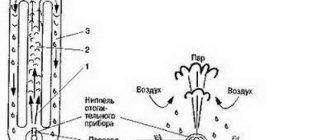How to make heating in a garage using antifreeze?
There are many ways to effectively heat your garage. One of the most effective is the use of a water heating system. Due to their many advantages, the demand for them is quite high. But they have one big drawback - in severe frosts, the water in the pipes can freeze. To avoid this, many garage owners add various antifreezes to the complex. As practice shows, the garage heating system using antifreeze is quite effective.
Types of equipping a garage with a heating system with antifreeze as a coolant:
- installation of the system from scratch, taking into account the properties of antifreeze;
- adaptation of the existing water heating system for the use of antifreeze:
- revision of technological connections and joints;
- installation of additional radiators;
- installation of exhaust ventilation.
Which garage heating is better?
Before organizing heating of the garage with your own hands, you first need to decide what fuel will be used.
- Solid (firewood, sawdust, pallets, coal, etc.)
- Liquid (fuel oil and diesel).
Electric energy (the most expensive option) and gas can also be used for these purposes. Each of the above types has its own characteristics, which will require the use of suitable equipment. To decide which heating is best for a garage, you need to familiarize yourself with the strengths and weaknesses of each of them.
Advantages and disadvantages
Attention: Antifreeze does not freeze in heating systems even in severe frosts. This is precisely its main advantage. The maximum that can happen to him is that he will turn into a jelly-like substance. But this will not affect the quality of heating in any way. After all, when heated, it will become liquid again.
Antifreeze can be used effectively in high-temperature circuits, as it has a high boiling point, which is 110-125 degrees. But when choosing a temperature mode, you need to take into account that it heats up more slowly than water.
Antifreeze has not only advantages, but also some disadvantages that should definitely be taken into account.
The disadvantages of antifreeze are:
- High viscosity compared to water. To pump it through pipes, additional power will be required. The circular pump will need to be replaced with a more powerful one.
- The heat capacity of this coolant is 1-15% lower than that of water. To compensate for this, it will be necessary to install additional radiator sections, heat exchangers, etc.
- High fluidity, which requires good sealing of all connections on the heating system. Rubber gaskets should be replaced with paronite gaskets.
- The service life of antifreeze, like many other antifreezes, is no more than 5 years. After which, it needs to be completely replaced.
- When stagnant, it forms white flakes, which, when settled, can ruin the heating structure.
Antifreeze has one more drawback. The most significant. It's poisonous. It is necessary to use this composition in the heating system so that it cannot enter the room. The heating system must not have any leaks and be sealed at the connections. After all, as already mentioned, the fluidity of this substance is greater than that of water, and it can leak even through a minor crack.
A leak of antifreeze is not immediately detected, and in order to avoid inhaling its vapors, which easily escape under the influence of high temperatures, you should carefully consider the condition of the heating system and inspect it from time to time for any damage.
Attention: If a leak is detected, you should immediately fix it, ventilate the garage and thoroughly wash the floor.
In addition, under no circumstances should it be poured into the heating system if a double-circuit boiler is used, since the substance can easily get into the hot water circuit and the consequences of this will be very unpleasant.
Requirements for a heating system in a garage
In principle, if desired, you can install any heating system for a garage, the main thing is that some nuances are taken into account:
- It is best if you install the heating system during the construction of the garage.
- Generally accepted standards suggest the optimal temperature in winter for storing cars is about -5 degrees. Therefore, when choosing the power of your heating, take this fact into account.
- The heating system is especially important in concrete and brick garages, because these materials themselves are not capable of retaining heat.
- To create a favorable indoor climate, it is necessary to consider ventilation and thermal insulation.
- If you are planning heating using a potbelly stove, then supply ventilation must be equipped.
- It is strictly forbidden to use heating devices whose power is much higher than that in your wiring.
- When installing air heating systems, they must be located as far as possible from flammable objects.
- Do not leave heating devices on without your presence, especially at night.
- When installing electric heating, it is necessary to install automatic fuses to de-energize the system in the event of a short circuit.
- If you store explosive compounds in your garage, then using gas heating is strictly prohibited.
When you decide what type of heating to install in your garage, be sure to consider the material from which it is made.
Filling the heating system
If you are not afraid that antifreeze is poisonous and you decide to pour it into the heating rack, you need to fully comply with safety precautions both when pouring and during subsequent operation.
Remember, before pouring, the antifreeze should be diluted. It should not be used in concentrated form, as it can cause damage to the heating boiler and circulation pump. When diluting antifreeze, you can independently choose the desired ratio of water and antifreeze. But first you should find out the lowest temperature at which its crystallization is possible. Most often, such information is available on the packaging.
Attention: Before pouring antifreeze, you should select the correct temperature conditions. Its name indicates the temperature at which its crystallization occurs. For example, A40-M (-40 degrees). Please note that the finished coolant should not be diluted with water. It is necessary to use concentrates that consist of 95% ethylene glycol. Using it for pouring, you can independently select the desired ratio of concentrate to water.
When diluting it with water, it should be taken into account that if it freezes at a temperature of -40 degrees, then the ratio of water and concentrate should be 1:1. At freezing temperature - 30 degrees 2:3. And if freezing occurs at -20 degrees, the ratio is 1:2.
Before pouring it into the heating system, all existing coolant should be drained from it, and the radiators and pipes should be thoroughly rinsed. All internal contamination must be removed. It is best to wash several times to achieve better results. If any antifreeze was previously poured into the system, it must be completely drained. You should not mix it with the antifreeze you are pouring.
The system used to heat a garage using antifreeze requires sealing the heating system and replacing rubber gaskets. If necessary, detected violations should be corrected. Pressure testing must be carried out, which is necessary to check the heating system for possible excesses of normal pressure. Thanks to this procedure, hidden defects can be detected.
But first you should find out the quality of the concentrate to find out whether it can be poured into the heating system. To find out, make a solution in a small glass container and leave it for several days. The temperature should be room temperature. If no foam or sediment forms, it can be used. Otherwise it should not be used.
Only after all these procedures, using a special pump, should you start pouring antifreeze. This should be done carefully.
Attention: Be sure to use a protective suit, respirator and gloves. The garage should be well ventilated at this time. If it gets on your skin when pouring, you should immediately wash it off with water. If you have a chemical burn, consult a doctor.
Heating system
Heating your garage with antifreeze requires the installation of larger radiators and a more powerful circulation pump. In addition, attention should be paid to installed radiators and pipes. Since antifreeze and many similar antifreezes are made on the basis of ethylene glycol, you should find out in advance whether they can be used as a coolant in the presence of aluminum or bimetallic radiators and galvanized pipes.
Types of antifreeze: green, red, blue. Which one to choose - the differences and effects of each on the metal of the heating system and components.
Otherwise, the antifreeze used may have a negative impact on the heating system, for example by causing metal corrosion.
Before pouring antifreeze, be sure to make sure that it will not cause harm to your heating system. Also, consider the risks and costs associated with its operation. Please note that the lower the concentration of coolant, the less likely it is to get burned if it gets on your skin.
Antifreeze can be used quite effectively for heating a garage. Its use allows you to achieve warmth in it and avoid freezing of the system even in severe frosts. But it should be used with caution, as it is very toxic. When using it, you must follow safety rules. Do not use it under any circumstances if you have a double-circuit boiler.
Water heating system
You need to understand that installing water heating makes sense when you are in the garage all the time. Otherwise, the costs will not justify themselves, because in addition to a source of heat and fuel, you will need to buy:
- cast iron or steel batteries (as an option, weld registers from pipes);
- circulation pump;
- expansion tank;
- pipes on the main line;
- non-freezing coolant - antifreeze.
For reference. The garage space is heated periodically, so the system cannot be filled with plain water.
Knowing the need for the amount of heat to heat the room (calculated in the previous section), select the power of the radiators or determine the length of the pipes of the homemade register using the table:
In the table, t1 means the coolant temperature, t2 means the air in the room
The calculation method is as follows. We take a steel pipe DN 80 (Ø89 mm) and find out from the table that 1 m of length is enough to heat an area of 1.37 m². We take the square footage of the garage, for example, 20 m² and divide by this figure: 20 / 1.37 = 14.6 m - the total length of the heating part. We distribute it among 2-3 heating devices and cook the registers according to the drawing.
Use the circulation pump with the lowest pressure (4 m of water column), and the expansion tank with the minimum volume. Pipes - polypropylene, steel or metal-plastic size DN 15. Then install radiators on 2 opposite walls and assemble a simple two-pipe closed-type heating system connected to a heat source according to the following diagram:
Instead of a wood-burning stove with a water circuit, an electric boiler or other heat source is installed in the circuit
The following can be used as a water heating installation:
- a wood-burning or exhaust stove with a water circuit, shown in the diagram above;
- heat exchanger – samovar-type economizer installed on the chimney;
- an electric heating element mounted in a vertical steel pipe, as shown in the diagram;
- a full-fledged electric boiler or solid fuel unit.
The simplest electric boiler with a water register
Advice. Do not forget to add a filter to the circuit - a mud trap and ball valves to cut off the heat source and drain water from the system. At the top point, install an automatic air vent, and on the batteries - Mayevsky valves for bleeding air.
Why don’t we recommend making an open-type system in the garage, as it is simpler and cheaper? The reason is antifreeze, which will evaporate from an open tank, which is unsafe for health (ethylene glycol is poisonous), not to mention the price of the coolant.
Main types of garage heating
The choice of heating system and type depends on the location of the garage. If the building is located near the house or on site, with a gas pipeline connected, in this case everything is simple; by installing a gas boiler, you can install a pipeline and install heating devices.
If you need to install heating in a garage cooperative, such a system can be equipped using:
- an expensive system with electrical appliances or a boiler;
- heating from a gas boiler powered by cylinders. This is not the cheapest method; you will need to spend money on refilling cylinders;
- using wood or coal as fuel will require the allocation of space in the garage for fuel storage. But this scheme is the cheapest and it is possible to make a furnace with a water circuit yourself if you have skills in electric welding;
- An expensive universal means for heating a garage - an electric - wood-burning boiler for heating. This scheme is available when installed in several bays of car repair shops;
- The cheapest and most accessible way to heat a garage with water is a homemade or industrial stove that runs on used motor oil. Such fuel is available, does not take up much space in the garage, and a system filled with antifreeze will not defrost even at significant sub-zero temperatures.
In any case, if you need to make water heating, it is better to fill the system with antifreeze. We'll talk about its positive and negative sides in the next chapter.
It is important to know! In the worst case, at a very low, prohibitive temperature, antifreeze turns into a jelly-like mass. It easily turns into liquid when the boiler is turned on.
Video description
Advantages and disadvantages of a pyrolysis type solid fuel wood boiler in the video:
Liquid fuel
This category includes heating devices that run on diesel fuel or waste engine oil. For obvious reasons, waste oil is more economical to use than diesel fuel, since it costs much less (sometimes it is available for free). But there's a problem. The oil can be purchased at service stations where the oil in cars is changed. But the service stations themselves use exhaust gas to heat the garage in the winter. Therefore, this type of fuel becomes scarce in winter.
As in the case of solid fuel boilers, there are economical models in the liquid fuel category. These are small-sized units that you can make yourself. Drawings and diagrams are freely available. But it should be noted that liquid fuel boilers, like solid fuel boilers, are fire hazardous equipment. Therefore, representatives of the State Fire Safety Inspectorate may not allow their installation in garages. And this is problem number two.
Furnace in operation Source eurodrova.ru
The main advantages and disadvantages of a system filled with antifreeze
The advantages of the method include:
- The boiling point of antifreeze is 1100-1250, so it is preferable to use it in individual heating systems with high fuel combustion temperatures. At the same time, the air in the room will heat up more slowly, so this feature of the coolant must be taken into account;
- prevents the formation of scale on the walls of boilers, and accordingly increases the service life of the equipment;
A heating system in a garage filled with antifreeze has its negative aspects, which include:
- a higher level of viscosity will require the installation of a powerful circulation pump;
- Antifreeze has a low level of heat capacity; to achieve a level of room heating similar to water heating, it will require the installation of additional sections on radiators;
- high penetrating ability of antifreeze requires tightness of all wiring connections;
- for gaskets you will have to use expensive paronite;
- water heating of a garage using antifreeze as a coolant will require a complete replacement of antifreeze in 4-5 years;
- the most important disadvantage is its toxicity to humans. Therefore, it is important to make the heating circuit completely sealed and monitor this constantly.
Important! For optimal, safe operating conditions of a boiler with a water circuit filled with antifreeze, it is important to choose the right coolant according to its composition. It is not recommended to dilute the finished antifreeze with plain water before filling the system. In this case, the freezing point of the liquid changes. Only special concentrates can be diluted, but strictly according to the instructions. Concentrated antifreeze consists of 95% propylene glycol.
Preparatory stage
The type of heating is chosen depending on the availability of coolant.
When planning to make heating in the garage with your own hands, you should focus on a number of criteria that affect the quality of the final result:
- type of building, attached or detached;
- the material from which the walls and ceilings are made;
- room size;
- cost of purchasing and installing equipment;
- availability and accessibility of fuel;
- required power;
- design safety;
- degree of device autonomy.
Heating a garage with an electric convector
In addition, you need to objectively evaluate the pros and cons of different heating systems:
- Water autonomous does not require any maintenance or control, but it is expensive to install and only works if there is current and a supply of fuel.
- Electricity allows you to get heat quickly, there is no need for intervention and refueling of devices. However, each volt-amp is very expensive, plus powerful wiring is required.
- A good gas boiler is easy to set up, economical, efficient and takes up little space. However, the cost of the initial investment may be prohibitive.
- Solid fuel is inexpensive, efficient, but produces a lot of smoke. A high-quality chimney and storage space for fuel are required.
- Air heating is rarely used, but the boiler is expensive and not everyone can afford it.
It makes sense to build a brick oven only in a large room. The product is multifunctional, capable of heating the entire garage, but requires a lot of costs during the construction and arrangement of a separate foundation.
After assessing all the characteristics, all that remains is to draw up a diagram, purchase materials and carry out installation.
The main way to properly prepare coolant for a garage heating system
The most popular for heating is concentrated antifreeze, with certain characteristics. In this case, using the instructions, you can prepare the antifreeze that is most suitable for your climate zone. Another advantage of this solution is that counterfeit ready-made antifreezes and antifreezes are most common on the market. But you should remember - the coolant is diluted only with distilled water.
First of all, you should determine the required maximum subzero temperature, after which the composition thickens and crystallizes. This can be achieved by proceeding according to the following scheme:
- when combining antifreeze and water in a ratio of 1/1 – the freezing point is 400 degrees below zero;
- if it is required that the coolant does not crystallize at -400 - in this case, the mixture is diluted 2/3;
- taking 1 part of the concentrate, adding 2 parts of the distillate - we get a coolant that does not freeze at -200.
To check the quality of the concentrate, you can do the following:
- dilute a small volume of the mixture in a certain proportion;
- pour it into a transparent glass container;
- leave the solution in the garage for several days at above-zero temperatures;
- inspect the solution if sediment has formed or foam has formed - it is not recommended to pour such antifreeze into water heating in the garage. Such formations indicate low quality of the concentrate.
When using a combination stove or boiler for a garage with antifreeze filled, it is important when replacing not only to properly dilute the concentrate, but also to fill the system with it.
Pour antifreeze into the garage water heating
To do this, you will need to prepare a garage heating system with your own hands. This is not a difficult, but responsible operation. We remove water from pipelines and registers. It is important to note that waste coolant cannot be poured under plants or onto the ground. It is better to collect it in containers and drain it into the storm drain.
Further operations are performed in the following order:
- It is important to rinse the pipes and radiators thoroughly; to do this, close the drain valve and fill the system with clean water. You can add citric acid, this treatment removes alkaline scale from pipes. After starting the boiler, heating the water, let it cool slightly and drain. The operation should be repeated several times.
- When filling with water for the last time, be sure to check all pipes, joints and registers for leaks and fistulas. When they are detected, such places are cleaned and boiled or crimped with clamps with paranitic gaskets. At all connections where there are rubber seals, it is necessary to replace them with paranit.
- After these operations, having filled the system, turn on the boiler, bring the temperature to operating temperature and check the tightness of the connections. Some experts advise pressure testing of the heating, but this is unnecessary, we do not have prohibitive pressures.
- Now pour liquid into the heating. It is important to do this evenly, in a small stream. You already know the optimal volume of antifreeze to fill the garage heating system. Remember that after filling the system, it is necessary to remove any air pockets from it. This is done at the top point of the system using a tap or it is equipped with an expansion tank.
Now you can start the boiler and once again check the tightness of the joints and the absence of air in the liquid heating system of the garage. It is important to remember that antifreeze is a toxic material. If the substance gets on the mucous membranes, they should be immediately rinsed with water. Carry out work with the gates of the box open.
In conclusion, some advice.
You can heat a garage using a potbelly stove or stoves, but fumes, smoke and space for storing firewood make this method costly and inconvenient. You don’t have to be smart and install an electric convector or boiler, but this technique significantly increases the figures on your electricity bill.
Regardless of the choice of types of liquid heating in the garage, we recommend using antifreeze as a coolant. Good luck.
Water heating
Along with ease of manufacture and efficiency, the potbelly stove also has one significant drawback: it cools quickly after the fuel burns out. To improve the efficiency of stove heating, it is recommended to build a water heating circuit.
To organize water heating of the garage you will need:
- Install heating devices throughout the room.
- Connect pipes to them.
- Hang a special expansion container at the top.
It is advisable to fill the system pipes with antifreeze, which will make it possible not to be afraid of defrosting in the event of prolonged heating downtime in winter weather.
Types of water circuits:
- Single-pipe . In this case, the coolant passes through all parts of the system, in a circle.
- Two-pipe . Here the heated water is supplied in the return pipe in a cooled form.
Single-pipe circuits are considered cheaper to install, however, such a circuit will have different temperatures in different areas. Strictly speaking, this is not critical for a garage. The heating device must be placed lower than the pipes: only in this case will water or antifreeze circulate normally. The movement of the coolant will be stimulated by heating from the potbelly stove.
If installing the stove below the entire system is not possible, a circulation pump will be required. Since heating of the coolant is usually accompanied by an increase in its volume, the highest point of the system is equipped with an expansion tank. Such circuits are volatile. If the power supply to the garage is unstable, it is better to get a 12 V circulation pump powered by a battery.
Two-pipe autonomous heating systems for garages are recommended for use in large spaces. In addition, in this case, you can also use heated floors, which involves laying special coils, followed by filling them with a concrete screed. The most significant disadvantage of a two-pipe system is the risk of it defrosting during irregular use.
To avoid such situations, antifreeze is poured into the circuit. For these purposes, special solutions based on glycerin and other chemical components are used: this will increase the durability of the system by an order of magnitude. The joints of a circuit filled with antifreeze may only be insulated with special sealants. Ordinary tow will come apart within a short time, and the pipes will begin to leak. Do-it-yourself heating in the garage using antifreeze is arranged according to the same scheme as water heating.
Antifreeze garage heating system
A garage often performs several functions for its owner. In addition to its main purpose of storing the car from intruders and natural disasters, it also serves as a repair area and a warehouse for spare parts, fuel and lubricants, and often a resting place. If it's summer outside, there are no questions. Open the gate, turn on the carrier and repair as necessary. But if the temperature outside is very sub-zero, then you can forget about a comfortable pastime or work. And it’s worth thinking about how to build heating in a garage using antifreeze with your own hands, if no other decisions have been made.
How to choose the type of garage heating
How to heat a garage space is the choice of each owner. It is necessary to choose the most practical of all the proposed methods. Among the numerous factors influencing decision making, the most significant are:
- Fuel type used
- Simplicity of the system
- Price
Introductory video review
https://youtube.com/watch?v=hD2Ud2ZdWFk
The location of the garage in relation to the residential building is of no small importance. If it is located at a distance from it, it is recommended to think about organizing an autonomous heating system
In cases where it is in close proximity, heating systems can be combined by laying pipes and installing 1-2 radiators.
When thinking about heating in a garage, many prioritize its compliance with the following requirements:
- Easy to use
- Ease of maintenance
- Efficiency
- Availability
The choice will be significantly influenced by the area of the room and the number of cars located in it.
For a small space, you don’t have to equip full-fledged heating, focusing on a small classic potbelly stove, a homemade boiler or a heat gun
Advantages and disadvantages of using antifreeze in a heating system
The main reason why antifreeze is poured into the garage heating system is that in this case there is no need to worry about the batteries defrosting during severe frosts. The crystallization threshold of antifreeze is much lower than that of ordinary water. Depending on the brand, it does not freeze at -20, -30 and even -40 degrees. Antifreeze, of course, may thicken somewhat, but this will have absolutely no effect on its qualities and when heated it will quickly turn into a liquid state again. At the same time, its boiling point is higher than that of water, so in this respect it is safer.
However, there are many more disadvantages, or more precisely, some inconveniences, of using antifreeze in a garage heating system installed with your own hands. It’s worth mentioning right away that these inconveniences relate rather to the process of assembling the system, during which it is necessary to observe certain safety measures and take into account the properties of this non-freezing liquid. All of them are worth listing and explaining a little:
- Viscosity. This property of antifreeze, which is much higher than that of water, requires the installation of a more powerful circular pump.
- The heat capacity, on the contrary, is much lower. That is, when the water heats up to 30 degrees, the antifreeze under the same initial conditions will only reach 20-25 degrees. And this can only be compensated for by installing additional radiators.
- Fluidity. This component is also high-grade, which means you will have to carefully check the system for cracks in order to avoid the slightest leak.
- With a long absence of circulation, in other words, stagnation of liquid, flakes can form, which, settling, can render the entire heating system unusable.
- Lifetime. Antifreeze will serve as a garage heating liquid for no more than five years. After this, you will have to drain it, thoroughly rinse the entire system and fill in a new one.
- And the main disadvantage of antifreeze is that it is poisonous. And not only the liquid itself, but also its vapor. And under the above-mentioned condition of increased fluidity, the possibility of it leaking and entering the atmosphere of the garage is very possible. If this problem is detected, you should immediately eliminate the cause of the leak, thoroughly rinse and ventilate the room.
There are many more disadvantages. However, this does not mean at all that you should forget about a garage heating system using antifreeze, installed by yourself. It’s just that all work on the installation of heat exchangers, heating radiators and pipes needs to be carried out more carefully and in compliance with all safety regulations.
First - insulation
Before starting autonomous heating of the garage, there is a reason to carry out at least minimal work on its insulation. Many people believe that these are one and the same thing, but reality shamelessly debunks established stereotypes. The best ones for this are:
- mineral wool;
- Styrofoam;
- thermal insulation paint.
Of course, ideally, all insulation work should be carried out outside - this way you significantly increase the fire safety of the technical room. However, it is often not possible to implement such an optimal plan, so everything has to be done from the inside, but with mandatory consideration of all safety requirements.
So, if you use polystyrene foam, then it must be impregnated with a fire retardant. In general, it is better to use penoizol - this material comes in the form of foam and does not burn, but is quite expensive.
Don’t forget about the insulating material on the floor - if the floor is cold, then no heating will make your garage even minimally comfortable. Also carefully inspect the room for cracks, and if you find them, seal the gaps with foam or rubber seals.
The final touch is a well-functioning ventilation system. This is one of the main requirements for organizing safety in premises where caustic fuels and lubricants are present and there is a risk of suffocation from exhaust and carbon monoxide.
Heating in a garage using antifreeze - installation details
Installation of the entire heating system begins from the stove.
- Based on our preferences and capabilities, we install a heating device in the selected location. Electric or gas boiler. A stove that runs on wood, exhaust or another type of fuel.
- We hang aluminum or cast iron radiators in such a way that the heating of the entire room is uniform.
- Pipes for connecting radiators to the stove should be selected taking into account the viscosity of the antifreeze. That is, their diameter must be at least 1.5 times larger than for water heating.
- The circular pump is installed in the system at a distance of at least 1 meter from the heating device. It is recommended to install shut-off valves on both sides. This is done so that it is possible, if necessary, to remove the pump, without having to drain the antifreeze from the entire system. The pump itself should be selected so that it is twice as powerful as when used in a similar heating system operating on water.
- We install the expansion tank as high as possible. The ideal option would be to take it to the roof
- Carefully connect all elements. It is better not to use threaded connections. This is due to the increased fluidity of antifreeze, which easily seeps through such connections. But a high-quality welding seam will easily hold it.
- Filling the antifreeze system is carried out as follows:
- Approximately 2/3 of the required volume is poured into the expansion tank.
- The circulation pump turns on.
- You should drive the system a little, carefully monitoring the antifreeze level.
- Add if necessary.
- After making sure that everything is working properly, there are no leaks and the antifreeze level is appropriate, you should carefully seal the expansion tank.
- Now you can start the stove for the first time.
- During the first month or two, it is recommended to conduct a daily visual inspection of the entire system, especially the joints and connections for leaks and other faults.
When installing a heating system in a garage using antifreeze, special attention should be paid to ensuring that all elements are made of materials that are neutral to the substances contained in this non-freezing liquid. Aluminum meets these requirements, but it is quite expensive and much more difficult to install. You can use thick-walled iron pipes, especially if your system includes a homemade stove.
Thoughts on heating a garage
When understanding the question of what is the best way to heat a garage, you need to understand one aspect. This is the availability of cheap fuel. For example, for some it is not a problem to get a lot of firewood for a minimal price. Otherwise, collecting used oil is not a problem. And for some it is easier to purchase several liquefied gas cylinders, install them outside the garage, and install a full-fledged piping with the installation of radiators.
That is, each owner of the building decides for himself what he wants to see in his garage as a heating system. As practice shows, those whose garage is an extension to the main house win. They simply connect the garage heating system (pipes, plus radiators) to the home heating system. And this solves the problem. Moreover, there is no need to turn off the heating at night.
The second position of reasoning is the choice of heating type. This refers to convection or forcing. The second option is more effective, and there are several reasons for this:
- high efficiency;
- simpler design features (no pipes and radiators);
- coolant – air that does not freeze at subzero temperatures;
- The temperature in the garage rises quickly.
The only negative is dry air.
Radiator heating Source istteks.ru
The third position concerns a complete heating system, which includes, in addition to the boiler or furnace, pipes and radiators. If the heating is turned off at night, then antifreeze must be poured inside, which increases the cost of the network.
Fourth position. Let us summarize which option for heating a garage is optimal.
- If we are talking about heating a garage with electricity, then the most economical way is infrared devices.
- The same applies to gas heating.
- If we decide to use liquid fuel, then it is more economical to use it. But on the condition that it is obtained free of charge or for a minimum payment. Let us add that used oil has maximum heat transfer. We can play on this by reducing its consumption.
- As for solid fuel equipment, everything will depend on what type of fuel is cheaper.
Other garage heating options
For regions with frosty and long winters, antifreeze in the garage heating system is the most acceptable option. However, there are other ways.
- Water heating. The system is identical to the one described above. Only instead of antifreeze, water is poured into it. Heats up faster. Among multi-level homemade products, one of the simplest. But in case of untimely start-up, it can lead to defrosting of the pipes and complete failure.
- Air heating. Probably the only system that does not have significant drawbacks. Installation is no more difficult. Can be left indefinitely without needing to reheat.
- Electric heating. Using air heaters, air guns and other devices. Practically safe, but very expensive.
- On liquefied gas. A gas heating boiler is required, to which a propane cylinder is connected. Quite an economical option, but there is a risk of fire. It is not recommended to leave a running installation unattended.
- Potbelly stove. A small iron stove that consumes all types of solid fuel. Fast heating, good heat dissipation. The disadvantages include the mandatory construction of a chimney and increased fire hazard.
Whatever type of heating system you install in your garage, the main thing is to understand that safety should always come first. Choose a place for the stove away from reserves of fuels and lubricants.
Do you need heating in the garage?
Water heating is the cheapest for a garage.
Drivers’ opinions regarding the need to heat a garage are based on the following criteria:
- It is inconvenient and sometimes impossible to service a car in the cold.
- Deterioration in the quality of technical fluids. Blockage of their circulation channels.
- The occurrence of condensation, as a result, accelerates corrosion of the body, frame, and equipment located in the room.
- Difficulty starting a cold engine.
- Battery drains quickly.
In the cold it is impossible to just sit alone or with friends, eat and drink coffee comfortably.


